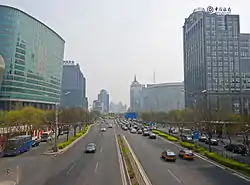Chaoyangmen Subdistrict
朝阳门街道 | |
|---|---|
 A main road in Chaoyaomen Subdistrict | |
.png.webp) Location of Chaoyangmen Subdistrict within Dongcheng District | |
 Chaoyangmen Subdistrict  Chaoyangmen Subdistrict | |
| Coordinates: 39°55′09″N 116°23′46″E / 39.9192°N 116.3960°E | |
| Country | China |
| Municipality | Beijing |
| District | Dongcheng |
| Village-level Division | 9 communities |
| Area | |
| • Total | 1.31 km2 (0.51 sq mi) |
| Population (2020) | |
| • Total | 30,473 |
| • Density | 23,000/km2 (60,000/sq mi) |
| Time zone | UTC+8 (China Standard) |
| Postal code | 100005 |
| Area code | 010 |
Chaoyangmen Subdistrict (Chinese: 朝阳门街道; pinyin: cháoyángmén jiēdào) is a subdistrict in eastern portion of Dongcheng District, Beijing, China. It consists of 9 communities. As of 2020, this subdistrict has a population of 30,473.[1]
The subdistrict was named after Chaoyangmen (Chinese: 朝阳门; lit. 'Gate that faces the east'), a gate part of Beijing's city wall that once stood in the region.
History
| Year | Status |
|---|---|
| 1912 | Part of 1st Inner District |
| 1949 | Part of Dongcheng District. Following subdistricts were organized:
|
| 1955 | After redistricting there are three subdistricts left: Qianchaomian, Zhuganxiang and Dafangjia. |
| 1958 | The three subdistricts merged into Chaoyangmen Subdistrict |
| 1960 | Transformed into a commune |
| 1990 | Changed back to a subdistrict. |
Administrative Division
As of 2021, Chaoyangmen Subdistrict was divided into 9 communities, they are as follows:[3]
| Administrative Division Code | Community Name in English | Community Name in Simplified Chinese |
|---|---|---|
| 110101007001 | Shijia | 史家 |
| 110101007002 | Neiwu | 内务 |
| 110101007003 | Yanyue | 演乐 |
| 110101007005 | Lishi | 礼士 |
| 110101007006 | Chaonei Toutiao | 朝内头条 |
| 110101007007 | Chaoxi | 朝西 |
| 110101007009 | Zhugan | 竹杆 |
| 110101007011 | Dafangjia | 大方家 |
| 110101007013 | Xinxian | 新鲜 |
Famous Sites
See also
References
- ↑ "China: Bĕijīng Municipal Province". CityPopulation.de. Citing: China National Bureau of Statistics (web), Bureaus of Statistics in Beijing (web). Retrieved 30 September 2020.
- ↑ Zhong hua ren min gong he guo zheng qu da dian. Bei jing shi juan. Li li guo, Li wan jun, Wu shi min, 李立国., 李万钧., 吴世民. Bei jing: Zhong guo she hui chu ban she. 2013. ISBN 978-7-5087-4058-4. OCLC 910451741.
{{cite book}}: CS1 maint: others (link) - ↑ "2021年统计用区划代码和城乡划分代码". www.stats.gov.cn. Retrieved 2022-09-17.
This article is issued from Wikipedia. The text is licensed under Creative Commons - Attribution - Sharealike. Additional terms may apply for the media files.